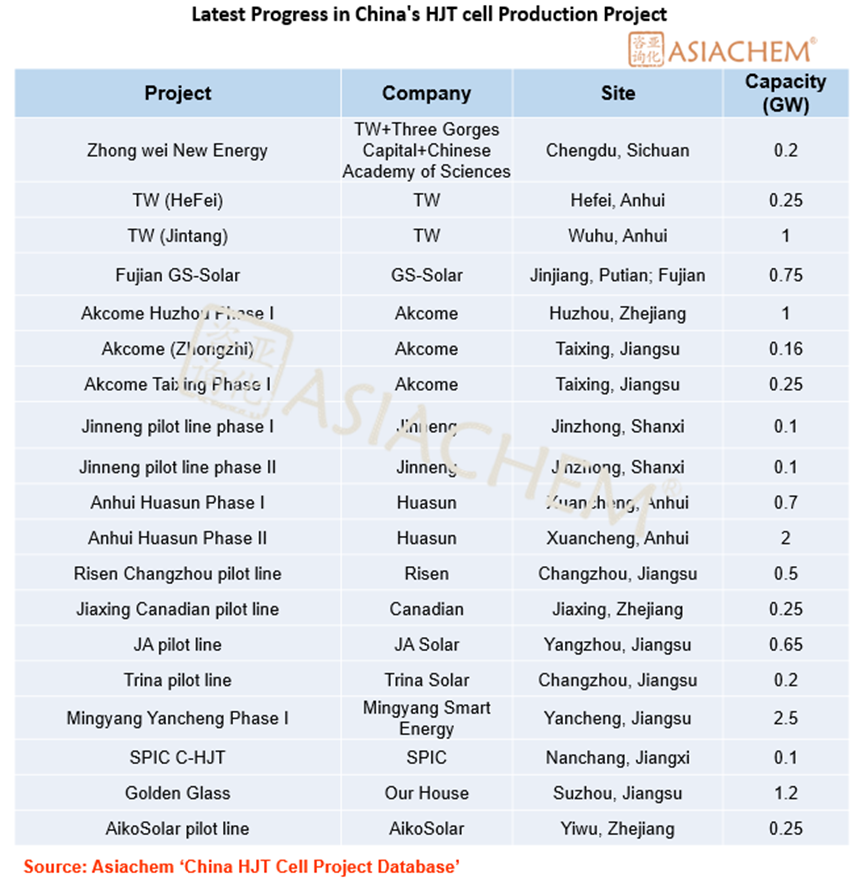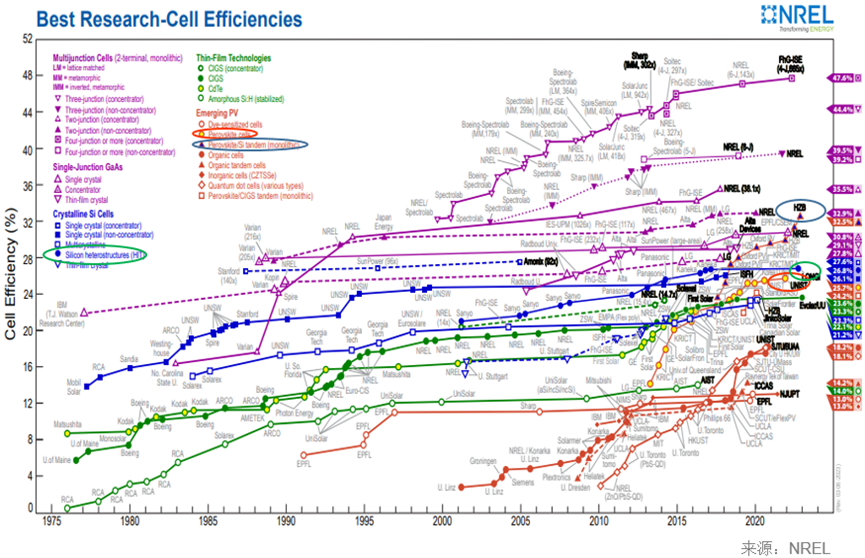In order to promote the development of wind power, photovoltaic industry and achieve the "dual carbon" strategy early, the government has recently released positive signals, creating a good policy atmosphere for the photovoltaic market. In 2022, 87.41GW of new photovoltaic installed capacity was added in China, an increase of 59.3% year-on-year. It is expected that in 2023, China's photovoltaic industry will soon usher in the era of adding 100-GW level of photovoltaic installed capacity.
Focusing on four aspects of high efficiency, high power, high reliability and high power generation, continuously reducing power generation costs will be the main direction of photovoltaic technology development in the future. According to the analysis of Asiachem Consulting, in 2023, PERC will still be the mainstream cell technology, and N-type technology will continue to maintain high heat, with multiple technological routes coexisting. However, as the mass production conversion rate of PERC has approached the "ceiling" and has entered homogeneous competition, cutting-edge technology is gradually transitioning to more efficient crystalline silicon solar cells. The iterative speed of the photovoltaic cell technology route will accelerate, and the mass production of N-type technology will officially begin, contributing to improving the reliability and power generation efficiency of photovoltaic systems.
Heterojunction: the Next Generation Ultra High Efficiency Cell Technology with the Most Industrialization Potential
As the next generation of ultra-efficient cell technology, Heterojunction(HJT) solar cell has the advantages of high conversion efficiency, simple manufacturing process, thin silicon wafer application, low temperature coefficient, no LID and PID, and bifacial power generation. From November to December 2022, Longi successively created the highest efficiency in the world of 26.81% HJT cells and 26.09% indium free HJT cells. Currently, the mass production efficiency of the HJT cell production line is around 25%, and there is huge room for efficiency improvement.
There are more than 50 domestic enterprises that have deployed HJT technology, mainly including Huasun, Jinergy, GS-Solar, Risen, Tongwei, Akcome, Mingyang, SPIC. Among them, Jinergy, GS-Solar, and SPIC have been laid out earlier, HJT production lines have been built, with a scale of more than 100 MW. New entrants such as Tongwei, Huasun, Golden Solar, Akcome, and Mingyang have announced the construction of GW-level HJT capacity, and gradually expanded their advantages.

According to Asiachem Consulting, by the end of February 2023, the total planned production capacity of China's HJT projects has reached about 380GW. Based on the investment amount of HJT cell equipment of 350 million yuan/GW, the total investment amount is as high as 133 billion yuan, bringing huge market opportunities for HJT equipment suppliers. Currently, China's actual built capacity is about 12.58GW. Most enterprises are still in the evaluation or planning stage, and have not yet formed a large-scale mass production stage.
Focus: Silicon wafer thinning to main melody
The development direction of silicon wafer cutting is mainly characterized by large size, thinness, fine line, flexibility, and intelligence. By reducing the amount of silicon wafer used and improving product yield, production costs are reduced.
Due to the amorphous silicon layer in the heterojunction battery, the temperature during the manufacturing process cannot be higher than 250℃. Therefore, the heterojunction mainly uses low-temperature silver paste, which is solidified at a temperature not higher than 200℃, and is not easy to cause silicon wafer warpage. Therefore, it is more suitable for the wafer reduction scheme.
According to data from CPIA, the thickness of HJT mainstream silicon wafer will decrease to about 130μm in 2022. There is still broad room for silicon wafer thickness to decrease, and silicon wafer manufacturers have also accelerated the process of thinning. Currently, the silicon wafer thickness of leading HJT enterprises has reached 120μm. Compared to PERC and TOPCon, the silicon wafer thickness is leading.
In January 2023, Golden Solar released a message that the Wujiang production line has been fully used 130μm wafers. In the future, Golden Solar will continue to import 110μm or 100μm wafers, and strive for low-cost mass production.
In January 2023, Risen reached a strategic cooperation with Gaoce in the field of N-type HJT ultrathin wafer cutting, and will further develop 100μm and thiner N-type HJT half-piece wafer. In addition, Risen stated in its February survey that currently, the thickness of silicon wafers mainly used in the company's HJT pilot line is 100-110μm. In the laboratory, the Risen has been testing and using silicon wafers with a thickness of less than 100 μm.
According to STCN, recently, Zhou Dan, CEO of Huasun, stated that Huasun has made significant progress in the development of HJT ultra-thin silicon wafers, and the company uses 130μm silicon wafer, the yield has exceeded 95.5%. The mass production process for 110μm and 120μm silicon wafers has been finalized as well as the yield has reached over 95%. 100μm silicon wafers is also being tested.
It can be seen that PV companies which are on the forefront of HJT cell R&D are actively developing applications of ultra-thin silicon wafers, and wafer thinning has become a research focus. 5th Perovskite, Heterojunction & Tandem Cell Forum 2023 will be held on April 19-21. Experts from Golden Solar, Risen and Huasun will attend the meeting and give a keynote speech.
Doubt: 0BB
Heterojunction is currently recognized as the mainstream technology path of photovoltaic cells, but the high cost is still restricting its development, in which silver paste accounts for nearly 40% of the non-silicon cost. There are three main ways to reduce the cost of silver paste: First, deposition of metal copper to replace the original silver as a metal grid line to collect the carriers generated by photovoltaic effect. The second is to reduce the consumption of silver paste by means of MBB or busbar-free. The third is to reduce the use of low-temperature silver paste by silver-coated copper and other methods.
0BB technology uses solder tape to collect finger current and realize cell interconnection, further promoting cost reduction and efficiency improvement. Using copper wire bonding strips instead of the silver busbar to directly collect the finger current and achieve interconnection between cells. The number of bonding strips is further increased compared to the number of busbar, and the width is further narrowed, helping to achieve cost reduction and efficiency improvement. From the perspective of cost reduction, the 0BB technology has achieved a cost reduction in aspects such as paste. From the perspective of efficiency enhancement, 0BB technology reduces the transmission distance of photogenerated carriers, effectively reducing the series resistance, and achieving a reduction in power loss. At the same time, it can reduce cell surface shielding and increase module power by about 1%.
0BB technology is in the early stage of industrialization, module and equipment manufacturers actively layout. The domestic R&D of 0BB technology is continuously advancing. In recent years, many types of 0BB modules have been introduced to the market, such as Akcome 0BB HJT module and Cando 210 0BB HJT module. In addition, domestic mainstream equipment manufacturers have also actively deployed 0BB equipment. Autowell, Maxwell, and Lead 0BB equipment have entered the pilot test and verification stage. It is expected that by 2023, the consumption of silver coated copper paste combined with 0BB technology will be reduced to 70mg per HJT cell, and the converted consumption per watt will be reduced to 10mg.
Currently, the industrialization of SmartWire is progressing slowly, with limited patents, and high process complexity. Can other mainstream 0BB technologies such as dispensing or welding achieve mass production applications in 2023? Can 0BB truly reduce the cost of modules? That is a doubtful point of HJT.
Hotspots: copper electroplating technology
Other metallization technologies mainly focus on reducing silver consumption to achieve cost reduction, while copper electroplating is a disruptive technology that can achieve complete silver-free. Due to the difficulty of its practical possibilities, once a breakthrough is made in R&D, it will have a huge impact, and it has been highly sought after by capital. Especially for the HJT cell technology with high silver paste costs, copper electroplating is a focus of attention. Currently, copper electroplating is mainly based on small batch production capacity. According to the HYM announcement, the large-scale production capacity of copper electroplating may be formed in 2024.
The copper electroplating electrode has a dense and uniform interior, and is connected to a transparent conductive film without obvious gaps. It has excellent electrical and contact properties, which can effectively improve electrical performance. Currently, the copper electroplating industry is in the pre pilot equipment testing stage, and leading equipment manufacturers such as CFMEE, KSDW, and ROBO-Technik have all started sending prototype tests to the downstream. With the implementation of equipment verification results this year, if the yield, efficiency, cost, and other test results are ideal, it is expected that the industry will enter the pilot stage in 2023 and enter mass production in 2024-2025.
There is no doubt that copper electroplating is an end in reducing silver, as it does not require the use of silver at all. In addition, efficiency improvement is its core competitiveness. However, the biggest drawbacks of copper electroplating are difficult process, expensive equipment, low yield and environmental pollution. For HJT technology, silver coated copper will still be the mainstream technology to promote in the short term.
Competition Points: HJT + Perovskite, Best Partner
The theoretical conversion efficiency limit of perovskite cells is higher than that of crystalline silicon cells, and there is great potential for improvement in the future. According to the latest NREL data, the photoelectric conversion efficiency of mainstream photovoltaic crystalline silicon cells is close to the ceiling. The maximum conversion efficiency of crystalline silicon cells in the laboratory is 26.7%, and the theoretical conversion efficiency limit is 29.3%. The laboratory photoelectric conversion efficiency of perovskite single junction cells is 25.7%, and the theoretical conversion efficiency can reach 33%. The theoretical conversion efficiency of perovskite tandem cells is about 45%, which has a high development space.

Generally, a tandem solar cell formed by perovskite solar cell and traditional crystalline silicon solar cell. Wideband gap perovskite materials absorb short/medium wavelength incident light, and narrow band monocrystalline silicon materials absorb medium/long wavelength incident light, allowing maximum utilization of sunlight. HJT and perovskite have a good matching degree of tandem cells, and HJT perovskite tandem cells can achieve higher photoelectric conversion efficiency: HJT can contribute 25% to 26% of the conversion efficiency, while perovskite tandem cells can increase their incremental benefits by 3% to 5%.
Among many photovoltaic technology paths, scientists have discovered that perovskite naturally fits HJT, and the tandem technology of them is considered to be the most promising combination. The structural characteristics of HJT are very suitable for forming tandem cell with perovskite as bottom cell. In addition, HJT tandem perovskite has a significant advantage. Both are made at below 200℃, and even perovskite requires lower temperature.
Although the future of HJT and perovskite tandem cells is bright, they are still in the laboratory stage and the development path is tortuous. Perovskite technology is still in the initial stage, and there are certain difficulties in achieving large-scale development. The stability improvement of perovskite solar cells has not achieved a critical breakthrough. Because the lead in perovskite is easily oxidized and volatilized, the crystal is easily decomposed when it encounters water. Therefore, perovskite solar cells have poor stability and short life in natural environments.
It is believe that with the deepening of industrialization, HJT and perovskite tandem technology will continue to improve, manufacturing costs will reduce, and the future development prospects are foreseeable!
5th Perovskite, Heterojunction & Tandem Cell Forum 2023 is just around the corner! This year's conference will be held on April 19-21 in Changzhou, Jiangsu, China. This conference will provide ZOOM Global Online Participation and simultaneous interpretation in Chinese and English.